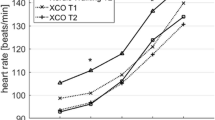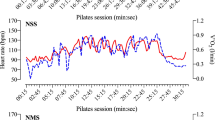Abstract
Background
The impact of a single-session Pilates exercise on cardiorespiratory fitness and metabolic parameters is still uncertain.
Aims
The aim of this study was to examine the cardiorespiratory changes during a single-session Pilates exercise and compare cardiorespiratory fitness-related parameters with walking at different speeds on a treadmill, at low (3.2 kph) and moderate intensities (4.8 kph).
Methods
Cardiorespiratory responses were measured with a cardiopulmonary exercise test device in 31 healthy young adults at rest, during a single Pilates session, walking at 3.2 kph and walking at 4.8 kph. The study design employed a cross-over design. Participants were randomly assigned to two experimental groups: a Pilates training session following treadmill walking or treadmill walking following a Pilates training session.
Results
Mean MET, oxygen and energy consumption during Pilates were similar to walking at 3.2 kph (p > 0.05), but significantly lower than walking at 4.8 kph (p < 0.05). The mean heart rate during Pilates was higher than walking at 3.2 kph (p < 0.05), but similar to walking at 4.8 kph (p > 0.05). Significantly higher carbohydrate metabolism was used during Pilates compared to walking (p < 0.05).
Conclusion
The cardiopulmonary responses to a single Pilates session are similar to walking at a speed of 3.2 kph but lower than walking at 4.8 kph. These results indicate that while Pilates may not generate sufficient cardiopulmonary changes to enhance cardiorespiratory fitness as a moderate-intensity exercise in healthy young adults, it may still offer other benefits such as improvements in flexibility, core strength, and posture.

Similar content being viewed by others
References
Ross R et al (2016) Importance of assessing cardiorespiratory fitness in clinical practice: a case for fitness as a clinical vital sign: a scientific statement from the American Heart Association. Circulation 13424:e653–e699. https://doi.org/10.1161/cir.0000000000000461
Raghuveer G et al (2020) Cardiorespiratory fitness in youth: an important marker of health: a scientific statement from the American Heart Association. Circulation 1427:e101–e118. https://doi.org/10.1161/cir.0000000000000866
Zeiher J et al (2019) Correlates and determinants of cardiorespiratory fitness in adults: a systematic review. Sports Med Open 51:39. https://doi.org/10.1186/s40798-019-0211-2
Fardman A et al (2021) Cardiorespiratory fitness is an independent predictor of cardiovascular morbidity and mortality and improves accuracy of prediction models. Can J Cardiol 372:241–250. https://doi.org/10.1016/j.cjca.2020.05.017
Gonzales TI et al (2021) Cardiorespiratory fitness assessment using risk-stratified exercise testing and dose-response relationships with disease outcomes. Sci Rep 111:15315. https://doi.org/10.1038/s41598-021-94768-3
Garber CE et al (2011) American College of Sports Medicine position stand. Quantity and quality of exercise for developing and maintaining cardiorespiratory, musculoskeletal, and neuromotor fitness in apparently healthy adults: guidance for prescribing exercise. Med Sci Sports Exerc 437:1334–1359. https://doi.org/10.1249/MSS.0b013e318213fefb
Magutah K, Thairu K, Patel N (2020) Effect of short moderate intensity exercise bouts on cardiovascular function and maximal oxygen consumption in sedentary older adults. BMJ Open Sport Exerc Med 61:e000672. https://doi.org/10.1136/bmjsem-2019-000672
Haskell WL et al (2007) Physical activity and public health: updated recommendation for adults from the American College of Sports Medicine and the American Heart Association. Med Sci Sports Exerc 398:1423–1434. https://doi.org/10.1249/mss.0b013e3180616b27
Wells C, Kolt GS, Bialocerkowski A (2012) Defining Pilates exercise: a systematic review. Complement Ther Med 204:253–262. https://doi.org/10.1016/j.ctim.2012.02.005
Guimarães GV et al (2012) Pilates in heart failure patients: a randomized controlled pilot trial. Cardiovasc Ther 306:351–356. https://doi.org/10.1111/j.1755-5922.2011.00285.x
Teixeira de Carvalho F et al (2017) Pilates and proprioceptive neuromuscular facilitation methods induce similar strength gains but different neuromuscular adaptations in elderly women. Exp Aging Res 435:440–452. https://doi.org/10.1080/0361073x.2017.1369624
Fernández-Rodríguez R et al (2019) Pilates method improves cardiorespiratory fitness: a systematic review and meta-analysis. J Clin Med 811. https://doi.org/10.3390/jcm8111761
Tinoco-Fernández M et al (2016) The Pilates method and cardiorespiratory adaptation to training. Res Sports Med 243:281–286. https://doi.org/10.1080/15438627.2016.1202829
Pessôa RAG et al (2023) Effects of Pilates exercises on cardiorespiratory fitness: a systematic review and meta-analysis. Complement Ther Clin Pract 52:101772. https://doi.org/10.1016/j.ctcp.2023.101772
Lim HS, Yoon S (2017) The effects of Pilates exercise on cardiopulmonary function in the chronic stroke patients: a randomized controlled trials. J Phys Ther Sci 295:959–963. https://doi.org/10.1589/jpts.29.959
Finatto P et al (2018) Pilates training improves 5-km run performance by changing metabolic cost and muscle activity in trained runners. PLoS One 133:e0194057. https://doi.org/10.1371/journal.pone.0194057
Azab AR et al (2022) Impact of clinical pilates exercise on pain, cardiorespiratory fitness, functional ability, and quality of life in children with polyarticular juvenile idiopathic arthritis. Int J Environ Res Public Health 1913. https://doi.org/10.3390/ijerph19137793
Vasold KL et al (2019) Reliability and validity of commercially available low-cost bioelectrical impedance analysis. Int J Sport Nutr Exerc Metab 294:406–410. https://doi.org/10.1123/ijsnem.2018-0283
Pritchard A et al (2021) ARTP statement on cardiopulmonary exercise testing 2021. BMJ Open Respir Res 81. https://doi.org/10.1136/bmjresp-2021-001121
Souren T, Rose E, Groepenhoff H (2021) Comparison of two metabolic simulators used for gas exchange verification in cardiopulmonary exercise test carts. Front Physiol 12:667386. https://doi.org/10.3389/fphys.2021.667386.
Fuller D et al (2020) Reliability and validity of commercially available wearable devices for measuring steps, energy expenditure, and heart rate: systematic review. JMIR Mhealth Uhealth. 89:e18694. https://doi.org/10.2196/18694
Rayes ABR et al (2019) The effects of Pilates vs. aerobic training on cardiorespiratory fitness, isokinetic muscular strength, body composition, and functional tasks outcomes for individuals who are overweight/obese: a clinical trial. PeerJ 7:e6022. https://doi.org/10.7717/peerj.6022
Park JM, Hyun GS, Jee YS (2016) Effects of Pilates core stability exercises on the balance abilities of archers. J Exerc Rehabil 126:553–558. https://doi.org/10.12965/jer.1632836.418
Albouaini K et al (2007) Cardiopulmonary exercise testing and its application. Postgrad Med J 83985:675–682. https://doi.org/10.1136/hrt.2007.121558
Hagins M, Moore W, Rundle A (2007) Does practicing hatha yoga satisfy recommendations for intensity of physical activity which improves and maintains health and cardiovascular fitness? BMC Complement Altern Med 7:40. https://doi.org/10.1186/1472-6882-7-40
Mendes MA et al (2018) Metabolic equivalent of task (METs) thresholds as an indicator of physical activity intensity. PLoS One. 137:e0200701. https://doi.org/10.1371/journal.pone.0200701
Manini TM (2010) Energy expenditure and aging. Ageing Res Rev 91:1–11. https://doi.org/10.1016/j.arr.2009.08.002
Li SSW et al (2018) Gender differences in energy expenditure during walking with backpack and double-pack loads. Hum Factors 18720818799190. https://doi.org/10.1177/0018720818799190
Almeida IDS et al (2021) Effect of three different Pilates sessions on energy expenditure and aerobic metabolism in healthy females. Sport Sciences for Health 171:223–231. https://doi.org/10.1007/s11332-020-00676-w
Haddock BL, Wilkin LD (2006) Resistance training volume and post exercise energy expenditure. Int J Sports Med 272:143–148. https://doi.org/10.1055/s-2005-865601
Santtila M et al (2013) Comparison between direct and predicted maximal oxygen uptake measurement during cycling. Mil Med 1782:234–238. https://doi.org/10.7205/milmed-d-12-00276
Manson JE et al (2002) Walking compared with vigorous exercise for the prevention of cardiovascular events in women. N Engl J Med 34710:716–725. https://doi.org/10.1056/NEJMoa021067
Moon JH et al (2015) Comparison of deep and superficial abdominal muscle activity between experienced Pilates and resistance exercise instructors and controls during stabilization exercise. J Exerc Rehabil 113:161–168. https://doi.org/10.12965/jer.150203
Gálvez JM et al (1985) (2000) Effect of muscle mass and intensity of isometric contraction on heart rate. J Appl Physiol 882:487–492. https://doi.org/10.1152/jappl.2000.88.2.487
de Souza Andrade L et al (2021) What is the exercise intensity of Pilates? An analysis of the energy expenditure, blood lactate, and intensity of apparatus and mat Pilates sessions. J Bodyw Mov Ther 26:36–42. https://doi.org/10.1016/j.jbmt.2020.12.007
do Espírito BCDR et al (2020) Acute effects of mat Pilates session on heart rate and rating of perceived exertion. J Bodyw Mov Ther 24(2):104–108. https://doi.org/10.1016/j.jbmt.2019.10.004
Spriet LL (2014) New insights into the interaction of carbohydrate and fat metabolism during exercise. Sports Med 44(Suppl 1):S87–S96. https://doi.org/10.1007/s40279-014-0154-1
Krustrup P et al (2004) Slow-twitch fiber glycogen depletion elevates moderate-exercise fast-twitch fiber activity and O2 uptake. Med Sci Sports Exerc 366:973–982. https://doi.org/10.1249/01.mss.0000128246.20242.8b
Venables MC, Achten J, Jeukendrup AE (2005) Determinants of fat oxidation during exercise in healthy men and women: a cross-sectional study. J Appl Physiol 981(1985):160–167. https://doi.org/10.1152/japplphysiol.00662.2003
Wolkodoff NE (2008) The fitness effects of a combined aerobic and pilates program: an eight-week study
Alvarenga GM et al (2018) The influence of inspiratory muscle training combined with the Pilates method on lung function in elderly women: a randomized controlled trial. Clinics (Sao Paulo). 73:e356. https://doi.org/10.6061/clinics/2018/e356
Lau C, Yu R, Woo J (2015) Effects of a 12-week Hatha Yoga intervention on cardiorespiratory endurance, muscular strength and endurance, and flexibility in Hong Kong Chinese adults: a controlled clinical trial. Evid Based Complement Alternat Med 958727. https://doi.org/10.1155/2015/958727
Lim HS, Kim YL, Lee SM (2016) The effects of Pilates exercise training on static and dynamic balance in chronic stroke patients: a randomized controlled trial. J Phys Ther Sci 286:1819–1824. https://doi.org/10.1589/jpts.28.1819
Funding
The assessment devices and physiotherapy laboratories used in this study was funded by the Department of Scientific Research Projects, Izmir Katip Celebi University (Project ID: 2017-2ONP-SABF-0008, Title: Establishment of Physiotherapy and Rehabilitation Vocational Skills, Education, Research, and Innovation Laboratory Infrastructure); https://www.ikcu.edu.tr/.
Author information
Authors and Affiliations
Corresponding author
Ethics declarations
Conflict of interest
The authors declare no competing interests.
Additional information
Publisher's Note
Springer Nature remains neutral with regard to jurisdictional claims in published maps and institutional affiliations.
Supplementary Information
Below is the link to the electronic supplementary material.
Rights and permissions
Springer Nature or its licensor (e.g. a society or other partner) holds exclusive rights to this article under a publishing agreement with the author(s) or other rightsholder(s); author self-archiving of the accepted manuscript version of this article is solely governed by the terms of such publishing agreement and applicable law.
About this article
Cite this article
Gultekin, S.C., Ozcan Kahraman, B. & Kahraman, T. Cardiorespiratory responses: Pilates compared to different walking speeds in healthy adults. Ir J Med Sci 193, 139–147 (2024). https://doi.org/10.1007/s11845-023-03468-6
Received:
Accepted:
Published:
Issue Date:
DOI: https://doi.org/10.1007/s11845-023-03468-6




